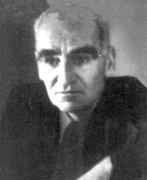Person: Bell (2), Eric Temple

Eric Temple Bell was a Scottish-born mathematician best known for his history of mathematics book: Men of Mathematics.
Mathematical Profile (Excerpt):
- James was a fish-curer and fruit grower, a fact which E T Bell did not mention in his autobiographical writings.
- Eric was the younger of his parents' two sons, the elder being James Redward Bell.
- From 1898 Bell attended Bedford Modern School where excellent mathematics teaching gave him his life-long interest in the subject.
- Bell realised that the boarding house he was living in was about to be destroyed by fire and, to save his precious books, he buried them in the garden.
- This school, which had been established in 1893, was destroyed by fire in 1916, five years after Bell left.
- In this work Bell further developed Eisenstein's extension of Gauss's determination of the regular polygons constructible with straight edge and compasses only.
- It was at the University of Washington that Bell gained a reputation as one of the leading mathematicians in the United States.
- The American Mathematical Society awarded him their Bôcher Memorial Prize in 1924 for his memoir, Arithmetical paraphrases which had appeared in the Transactions of the American Mathematical Society in 1921.
- In 1922 one of Bell's students began to show remarkable abilities, this student being Howard Percy Robertson.
- Having he graduated with his bachelor's degree in 1922, Robertson began studying for his master's degree and took Bell's course on mechanics.
- Bell had found the theory of relativity particularly stimulating and gave a course that was taken by Robertson.
- Bell confided in Hotelling that if he had not sunk fifteen years of his life into number theory, he would have loved to undertake research into relativity theory.
- He did persuade Robertson that this was a fascinating topic and, with Bell's encouragement, he went on to make a name for himself in this and related areas.
- In 1924 Bell was appointed to the Council of the American Mathematical Society.
- The award of the Bôcher Prize, and his growing reputation, saw Bell receive offers of professorships from several universities including the University of Michigan, Bryn Mawr University, and Columbia University.
- Bell neither accepted nor rejected these offers but tried to keep them open.
- Chicago tried to entice him to accept a professorship there but in early 1926 the experimental physicist Robert A Millikan from the California Institute of Technology got permission from the University Council to do everything possible to attract Bell to Caltech.
- Millikan had sought advice on Bell from L E Dickson, G D Birkhoff and Oswald Veblen beginning late in 1924, in particular asking if he was National Academy of Sciences standard.
- After an initial approach from Millikan, Bell played off a good offer from Columbia University to get an improved offer from Caltech.
- Dickson's prediction that Bell would soon be elected to the National Academy of Sciences proved correct: he was elected in 1927, three years before Bateman.
- Also in 1927 Bell was invited to give the American Mathematical Society Colloquium Lecture.
- Bell had the honour of being elected President of the Mathematical Association of America and he held the position during the years 1931-33.
- As President, he published problems and reviews in the American Mathematical Monthly.
- Bell wrote several popular books on the history of mathematics.
- He also made contributions to analytic number theory, Diophantine analysis and numerical functions.
- Two concepts which bear his name are the 'Bell numbers' and the 'Bell polynomials'.
- Although he wrote 250 research papers, including the one which received the Bôcher Memorial Prize, Bell is best remembered for his popular books, and therefore as an historian of mathematics.
- This original and scholarly book is an honour to American mathematics.
- At this level Bell wrote books which included Men of Mathematics (1937) and Mathematics, Queen and Servant of Science (1951).
- In addition to popular and high-level books, Bell also wrote many papers in which he gave his strong, often provocative, views on many subjects.
- Given the remarkable mathematical output of Bell, it is amazing that he was able to write two or three science fiction books each year.
- All these juicy horrors are described in such hair-raising detail and with such devilish pleasure that Bell's books almost all land in the can't-put-it-down class - even for some of Bell's squeamish academic colleagues who never meant to take them up at all.
- Although Bell (as John Taine) was known as one of the leading science fiction writers of his day, these books have not become classics and are today little read.
- Most people knew that Bell and Taine were the same man but the editor of the Pasadena Star-News decided to make a joke of it by asking John Taine to review E T Bell's 1934 book The Magic of Numbers.
- with matchless wit and insight, Eric Temple Bell has made 'The Magic of Numbers' ...
- The Bell garden, in its heyday, was ablaze with flowers even at that time of year when the neighbors were trying to force up a couple of crocuses.
- And even the Bell cats seemed somehow bigger and more prolific than most cats.
- Bell spent the last year of his life in Watsonville hospital.
Born 7 February 1883, Peterhead, Aberdeenshire, Scotland. Died 21 December 1960, Watsonville, California, USA.
View full biography at MacTutor
Tags relevant for this person:
Analysis, Origin Scotland
Thank you to the contributors under CC BY-SA 4.0! 

- Github:
-

- non-Github:
- @J-J-O'Connor
- @E-F-Robertson
References
Adapted from other CC BY-SA 4.0 Sources:
- O’Connor, John J; Robertson, Edmund F: MacTutor History of Mathematics Archive
